Early Theatre Deep Dive Pt 2: David Tennant in 'Twelve Angry Men' (1990)
..the performance at The Arches in Glasgow
Before you dive into this post, it’s pretty important for you to know all about the first run of this play. So if you haven’t read it already, I urge you to go away and read Part 1 here, and then come on back:
…..and now you’re back, let’s begin!
—
After the “dry run” April 1990 dates for Twelve Angry Men were done, there was little else for the cast to do than go back to class - after all, the Easter holidays were over and it was time to return to the RSAMD.
But the recently-turned nineteen-year old David was far from lazy! Between April and July, he fit in one last appearance in his mate Alan McHugh’s The Street at the Byre Theatre in St. Andrew (the last before this particular play would debut at the Edinburgh Fringe in August), and did a Theatre in Education tour of Strathclyde schools with three half-hour presentations of Macbeth (in the roles of Banquo and Macduff).
(And oh - if you’re interested in all the other ways David’s been tied into Macbeth, I got you! Just head this direction:
…and then hurry back!)
However, it wasn’t long before the summer school holidays were looming, and they could return to Twelve Angry Men. The cast reunited once again to re-rehearse the play in preparation for their set of July 1990 dates at the Arches Theatre in Glasgow. These were the “real” dates, the ones they’d formed Theatre Positive+ Scotland to do.
If you have any familiarity at all with the history of the Glasgow art and music scene, you’ll immediately recognize The Arches. But at the time Twelve Angry Men was scheduled to run there, it didn’t at all resemble the iconic venue which became so familiar to Glaswegians. No…the Arches which greeted the run of Twelve Angry Men in 1990 was an entirely different animal indeed.
The Arches most Glaswegians remember wasn’t born until 1991, the year after David’s run of Twelve Angry Men. Andy Arnold bought it, took the keys from British Rail, and reinvented the place under the brick arches into a space for clubbing, avant-garde theatre, and music. Sadly, it closed in 2015 and was replaced by a food market called Platform (which is what it was when I lived in Glasgow and wandered through in 2019). Today, however, the venue is much more than that - it’s an event space simply called Platform.
The first Arches, though?
Well - after Glasgow had been announced as the 1990 European City of Culture, Glasgow was suddenly inundated with public money to bolster its turn on the proverbial catwalk. A number of large-scale projects got off the ground. One of these was a £1.4M contract for the temporary refurbishment of twenty-two arches under Glasgow's Central Station, which had originally been a railway support structure built in 1906. Later, it had served as a warehouse for whiskey and then fell out of use. It was rediscovered in 1987 by a group of architects.
The site's owners, British Rail, didn't plan to do anything permanent with the space; all they mostly managed to do with it was redirect all the water literally running down the walls, and set up lighting, exits, and toilets. Their intent was for the finished space to hold a rather ambitious Year of Culture exhibition about the city called Glasgow’s Glasgow.

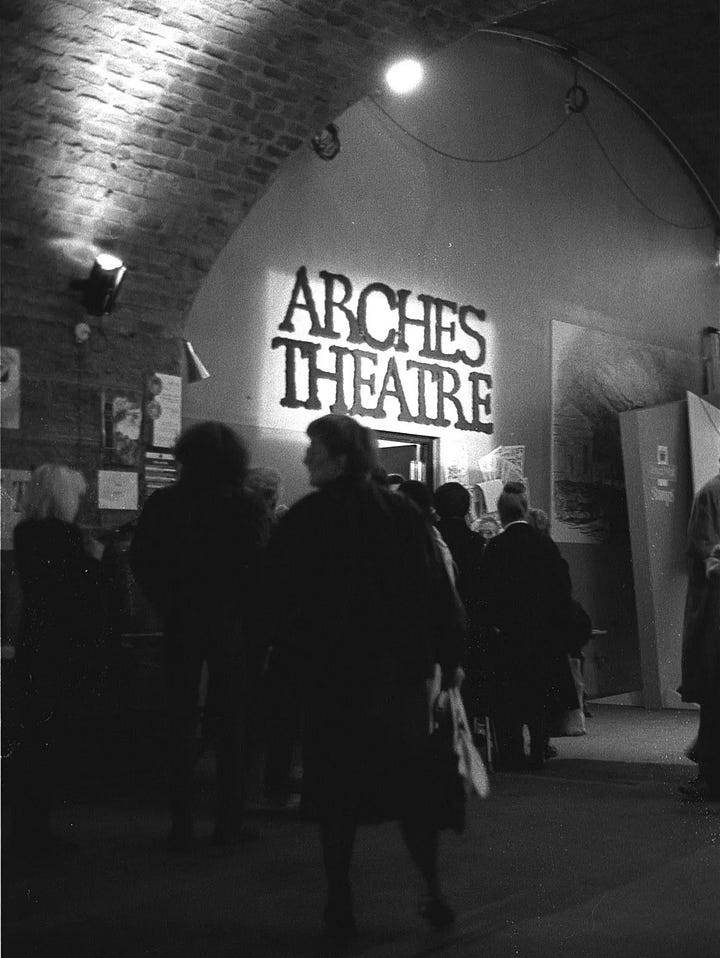
According to various advertisements, Glasgow’s Glasgow was the centerpiece of Glasgow’s turn as the European City of Culture. It assembled over 3000 artifacts of Glasgow history, industry and social life in an attempt to highlight the city's near-millennium of existence. The exhibition featured these artifacts through various displays, films, and video.
Another part of the exhibition? Live theatre! A company of actors employed by the exhibition hall under director Andy Arnold (and later known as the Arches Theatre Company) performed three to four promenade shows in the venue.
From “Repointing the Brickwork, The Birth of the Arches Theatre: Intro by Raymond Burke”, published at The Drouth:
At certain times during each day, all the piped music and sound effects were switched off and a troupe of actors would burst on to the scene in the middle of the exhibits to perform one of their fifteen minute shows such as The Story of St Mungo, Mary Queen of Scots and The Grave-robbers.
The original team were – Mark Saunders, Neil Herriot, Grant Smeaton, Ronan O’Donnell, Marie Claire McGuinness, Paula Macgee, Rosie O’Neill and Raymond Burke. When Neil and Mark left after a month or two, they were replaced by Tony Curran [of Doctor Who fame!] and Ross Stenhouse.
The actors also had access to and used the Glasgow’s Glasgow exhibition center’s newly-built, 114-seat theatre (aptly named The Arches Theatre) to hold evening shows. The venue opened in April 1990, and the first show held there was Will Ye Dance at My Wedding?, a Clyde Unity production written by Aileen Ritchie.
So when Twelve Angry Men made its debut at the Arches Theatre in July, the venue had only been open and running for three months.
-
With the debut of Twelve Angry Men creeping up, the cast and its director Iain Reekie reassembled and got down to rehearsals. I imagine they were able to use the RSAMD’s rehearsal rooms again to do so. And because the venue was so entwined with Glasgow’s Glasgow, and Theatre Positive+ Scotland was one of the many organizations participating in the Glasgow 1990 Year of Culture Program, I’m fairly positive (though not 100% sure) they were also able to use the Arches Theatre rehearsal spaces now and again.
The cast of Twelve Angry Men said rehearsals were a joy. They even took some time to lark about and blow off some steam!
“I have fond memories of the production,” Sam Ellis [role: Foreman] told me. “It was a happy cast and crew. Rehearsals were very playful. Alan McHugh [role: Juror #7] - a very talented musician - even turned it into an improvised musical one afternoon when there was a piano in the rehearsal room!”
-
There was a lot more publicity for the run-up to the debut of Twelve Angry Men at the Arches than there was for its dry run premiere at the Third Eye Centre. There were a number of reasons for this.
First, as I mentioned in my last feature on the play, its short run at the Third Eye Centre had earned a good bit of cash for Scottish AIDS Monitor. Second, the production had received rave reviews - someone I’ve spoken with recently who saw it said he and everyone else who had attended were “blown away by it”. So there was an eagerness to see more.
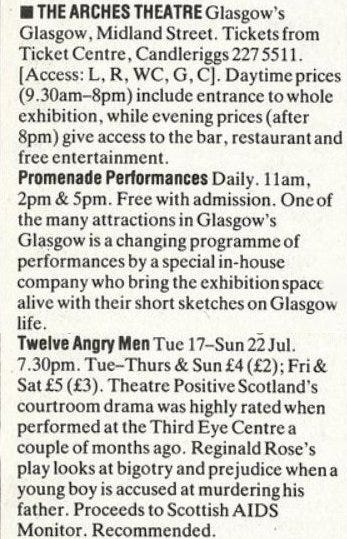
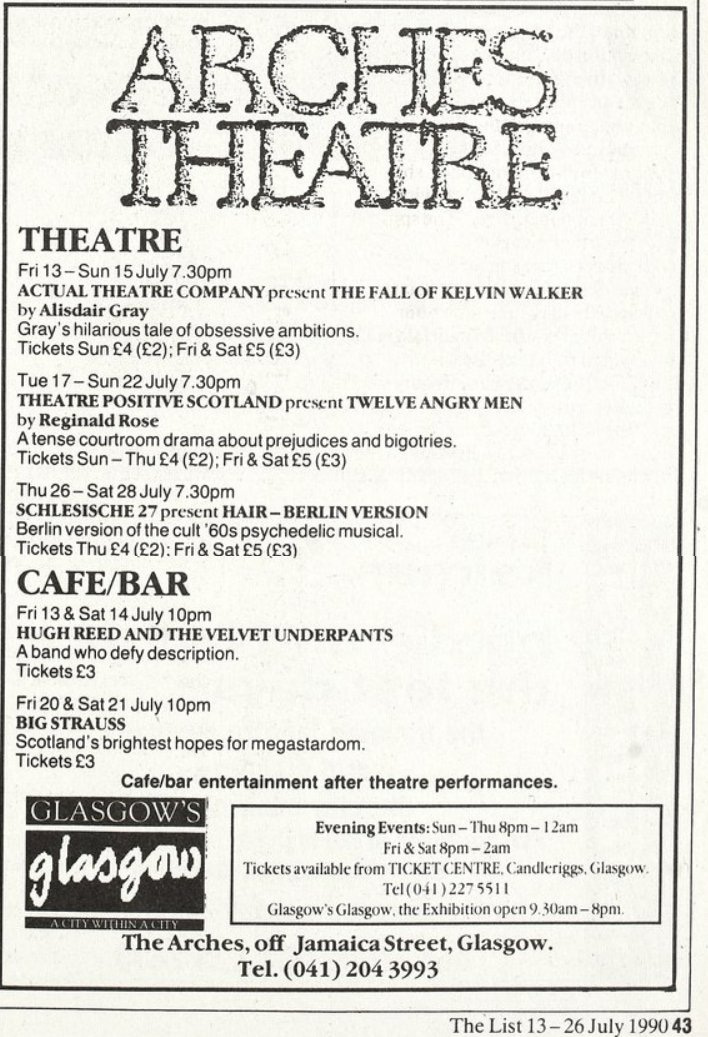
Another big reason was founding member of Theatre Positive Scotland (and Twelve Angry Men’s director) Iain Reekie. He got quite a lot of buzz. I was told by more than one cast member that Reekie’s work on the production proved pivotal to his later career.
I’ll discuss this subject in greater detail in the wrap-up section of my third installment of Twelve Angry Men, but for now, I’ll limit myself to noting this: both Sam Ellis [role: Foreman] and David’s teacher Peter McAllister told me that at some point David Hayman - then the Artistic Director of the 7:84 Scottish People's Theatre - had attended a performance of Twelve Angry Men in Glasgow.
In addition to all the printed publicity, Theatre Positive+ Scotland also posed for an in-costume cast shoot upon the front steps of the RSAMD/Royal Conservatoire!
I can’t tell you how excited I was to find the photo below when it sprung out at me from a microfilm reader in the Mitchell Library in Glasgow back in 2019. Even though the photo was of fairly dismal quality, I still have to say I’m very lucky I remembered to hoot my happiness using my “Library Voice”. Ha!
The resulting photo was published in the Glasgow Evening Times on 9 July 1990, a few weeks before the show’s debut:

Now I’m sure all you eagle-eyed David Tennant fans will be able to spot him immediately…but here’s the identification of the whole cast:
Front row, left to right: James Ryan, Cathal Quinn, Scott Cleverdon.
Left to right, standing: Steven Leach, William Leslie, Ashley Collishaw, Greg Wise, Alan McHugh, Simon Crowther, Tom McGovern, David Tennant, Robert Ellison [Sam Ellis].
—
When the cast of Twelve Angry Men finally walked onstage at The Arches Theatre for the first performance, it’s likely they were walking onto something that looked a bit like this (even though this was taken some twenty years later!):
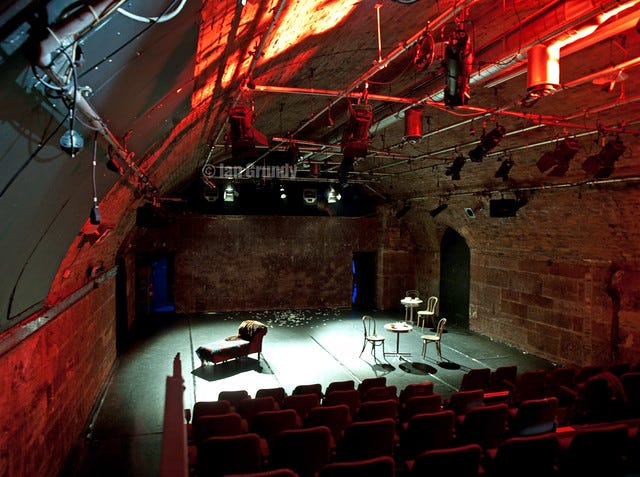
Anyone lucky enough to attend a performance was handed one of these when they walked through the door:

Twelve Angry Men ran at the Arches Theatre in Glasgow for six nights from Tuesday, 17 July 1990 to Sunday 22 July 1990 at 7:30 pm. Tickets were £4 (£2 concession price) on Tuesday-Thursday and on Sunday, and £5 (£3 concession price) on Friday and Saturday.
Afterwards? The show closed and the buzz faded, and the cast went their separate ways. They weren’t yet to know they’d get one more chance to revisit the play nine months later.
In the meantime, David was still a student at the RSAMD and had many other plays to think about and performances to give. He went to the Fringe with The Street and The Miser, traveled to Palermo for the Teatro E Scuole Di Teatro Festival (I wrote about that in an earlier post here):
…and graduated from a Second Year BA student to a Third Year BA. He helped out a good friend who found himself in a bind and needed an extra actor. He did Wax Fruit, a Jack and the Beanstalk panto, a role in The Fruits of Enlightenment and one in the RSAMD Music School's Mozart From A to Z. He directed Macburgers (which I wrote about here:)
…and attended a masterclass with Prunella Scales and Timothy West where he did a little bit of Hamlet (which I wrote about here):
And then?
Well, Twelve Angry Men would make its way around again.
—
The cast of Twelve Angry Men shared some of their memories of the performances with me.
Stephen Hogan, who played the role of the Guard in the Third Eye Centre dates and at the Arches, said he remembered it was an excellent production. “I was a First Year DDA at the RSAMD, and David was the year ahead of me on the BA course. I was delighted to do what I could, as it was my first job on a professional stage even though we were all students.” He went on. “We were all very committed to it. I only had a tiny part as the Guard, and wasn’t free for one of the runs.”
“We had Stephen in all but one run,” Collishaw [role: Juror #5] confirmed. “The Guard is a role that appears at the very start and the very end of the play, so it was a lot to ask someone to be there every night just for thirty or so seconds standing there.”
All the members of the cast had studied RP for three years as part of their training, but as they were committed to keeping Twelve Angry Men as American as possible, that meant performing the play with American accents. It was something they hadn’t done that much (if any) training for…but they gave it their best shot.
During their run at the Third Eye Centre, reviews had mentioned that their attempts at “various forms of American accents” were a little unsteady. According to Sam Ellis [role: Foreman], this unsteadiness continued into the run at the Arches. “I was born in France and brought up on Vancouver Island, Germany, Wales and Devon,” he said, “so the Canadian obviously came in handy for Twelve Angry Men. But there was quite a mixture around the courtroom table!”
Ellis added one more thing.
“We were thrilled that it was so well received!”
-
Next time — we’ll explore Twelve Angry Men’s final April 1991 run at the Cumbernauld Theatre in Cumbernauld!


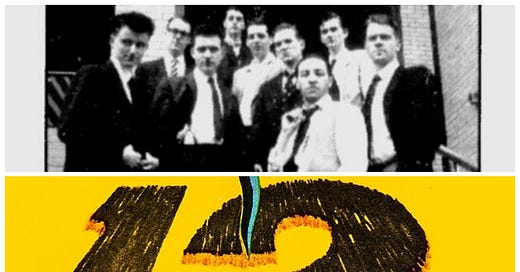






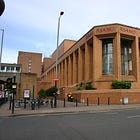
Nice to learn about the Arches and to see the great photo of a very serious looking DT. Thank you.